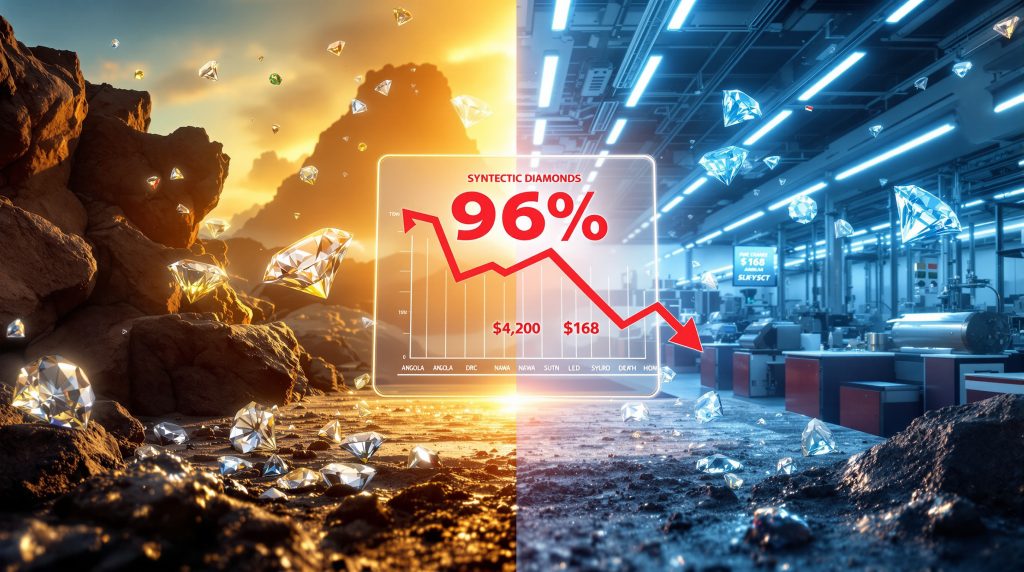Understanding the Lab-Grown Diamond Market Transformation
The synthetic diamond industry has experienced a dramatic market correction throughout 2025, with fundamental shifts altering how consumers perceive and purchase these manufactured gems. What began as a promising alternative to natural diamonds has evolved into a cautionary tale of oversupply and declining consumer confidence, as lab-grown diamonds are increasingly losing appeal among luxury jewelry buyers.
Manufacturing capabilities that initially democratised access to diamond-like products have instead created market conditions where record‑high gold prices continue to drive investors toward precious metals whilst synthetic diamonds rapidly lose their premium positioning. The dramatic price declines witnessed across all carat weights reflect deeper structural challenges within the synthetic diamond sector.
Market Size vs. Value Perception Disconnect
Despite earlier projections suggesting robust growth potential, the lab-grown diamond market faces a fundamental paradox. While production volumes continue expanding globally, wholesale pricing has collapsed to levels that challenge the category's viability as a luxury good.
According to industry analyst Edahn Golan, referenced in recent market coverage, the average wholesale price of one-carat lab-grown diamonds has plummeted by 96% since 2018, falling from approximately $4,200 to just $168. Two-carat stones have experienced identical percentage declines, demonstrating that this price collapse affects all major size categories.
This dramatic devaluation occurs against a backdrop where natural diamond markets, while experiencing their own challenges since mid-2022, maintain relatively stable pricing structures and established resale mechanisms. Furthermore, the mining industry trends indicate significant technological advances that continue to improve extraction efficiency.
Production Scaling Impact on Exclusivity
The rapid expansion of manufacturing capabilities, particularly across China and India, has fundamentally altered supply-demand equations within the synthetic diamond sector. Unlike natural diamonds constrained by geological availability and mining limitations, lab-grown alternatives face theoretically unlimited production capacity.
This manufacturing flexibility, initially viewed as an advantage, has eliminated the scarcity principle that drives luxury goods appeal. When production can be scaled infinitely through controlled laboratory processes, the exclusivity factor that consumers associate with premium jewellery categories becomes obsolete.
Why Are Lab-Grown Diamond Prices Collapsing?
The spectacular decline in lab-grown diamond pricing stems from multiple converging factors that have created an oversupply crisis unprecedented in the jewellery industry. This collapse represents more than typical market fluctuations, indicating fundamental structural problems within the synthetic diamond sector.
The 96% Price Drop Reality
| Carat Weight | 2018 Wholesale Price | 2025 Wholesale Price | Percentage Decline |
|---|---|---|---|
| 1 Carat | $4,200 | $168 | 96% |
| 2 Carat | $16,800 | $672 | 96% |
| 3 Carat | $37,800 | $1,512 | 96% |
These price reductions, documented through industry analysis, demonstrate how rapidly manufactured diamonds have transitioned from luxury goods to commodity-like products. The consistency of the 96% decline across different carat weights indicates systemic market forces rather than temporary price adjustments.
Oversupply Crisis in Manufacturing Hubs
Chinese and Indian production facilities have dramatically increased output capacity, creating supply volumes that traditional market mechanisms cannot absorb. This manufacturing boom has transformed controlled luxury production into mass-market commodity manufacturing, particularly as supply‑demand volatility affects various commodity markets globally.
The technological processes underlying lab-grown diamond production, including High Pressure High Temperature (HPHT) and Chemical Vapour Deposition (CVD) methods, enable rapid scaling that natural mining operations cannot match. This scalability advantage has become a market disadvantage as unlimited supply potential eliminates pricing power.
Consumer Confidence Erosion
When buyers witness such dramatic price volatility, their perception of lab-grown diamonds as stores of value diminishes significantly. Feriel Zerouki, President of the World Diamond Council, has observed that crashing prices are directly impacting consumer confidence in synthetic gems.
Unlike traditional luxury goods that maintain or appreciate in value over time, lab-grown diamonds now face perception challenges as rapidly depreciating fashion accessories rather than investment-grade jewellery pieces.
How Do Natural Diamonds Compare in Today's Market?
The synthetic diamond market collapse has created opportunities for natural diamond advocates to reinforce messaging around rarity, geological significance, and established value retention. This positioning strategy emphasises characteristics that cannot be replicated through laboratory manufacturing processes.
The Exclusivity Factor Returns
Natural diamond proponents are leveraging the synthetic market's pricing crisis to highlight irreplaceable formation processes spanning billions of years. These geological time scales represent authenticity markers that manufactured alternatives cannot duplicate, regardless of technological advances.
The finite nature of natural diamond deposits contrasts sharply with unlimited lab-grown production capacity, creating scarcity-based value propositions that appeal to consumers seeking genuine luxury experiences. However, global trade impacts continue to influence pricing across luxury commodity markets.
Investment Value Considerations
While natural diamond markets experienced price pressures beginning mid-2022, the sector maintains established resale infrastructure and historical value retention patterns significantly superior to synthetic alternatives. Natural stones continue demonstrating resilience through established secondary markets and collector demand.
Key Comparison Factors:
• Established resale markets with decades of transaction history
• Finite supply constraints preventing oversupply scenarios
• Cultural significance spanning generations of consumer tradition
• Geological authenticity providing unique provenance stories
Bridal Market Dynamics
The engagement ring segment represents perhaps the most significant battleground between natural and synthetic options. Traditional consumers increasingly view natural stones as more appropriate for lifetime commitments, while lab-grown alternatives become relegated to fashion jewellery applications.
Industry experts warn that synthetic diamond pricing could decline to levels where these products function primarily as fashion accessories, losing competitive positioning in premium bridal markets where emotional significance and value retention remain paramount considerations.
Which Consumer Segments Still Prefer Lab-Grown Diamonds?
Despite widespread price declines and confidence erosion, certain consumer segments maintain interest in lab-grown alternatives based on specific value propositions that extend beyond traditional luxury considerations.
Ethical and Environmental Conscious Buyers
Younger demographics continue gravitating toward synthetic options based on sustainability concerns and conflict-free sourcing guarantees. These consumers prioritise ethical considerations over traditional luxury markers, viewing lab-grown diamonds as solutions to mining-related environmental and social issues.
Environmental messaging around synthetic diamond production emphasises reduced ecological impact compared to traditional mining operations, appealing to consumers who prioritise sustainability in purchasing decisions.
Fashion and Customisation Markets
The manufacturing flexibility inherent in lab-grown production enables applications that natural diamonds cannot economically support:
• Unlimited colour options through controlled manufacturing processes
• Consistent quality specifications achievable through laboratory controls
• Affordable experimentation with larger sizes for fashion applications
• Rapid production timelines enabling custom designs and quick turnarounds
• Fancy coloured diamonds previously unaffordable in natural form
Budget-Conscious Luxury Seekers
Consumers seeking diamond aesthetics without premium pricing find lab-grown options increasingly attractive as fashion accessories rather than investment pieces. The dramatic price reductions have made larger stones accessible to broader consumer segments, albeit with recognition of limited resale value.
This market positioning reflects a fundamental shift where synthetic diamonds compete primarily on affordability and accessibility rather than luxury positioning or investment potential.
What Industry Initiatives Are Promoting Natural Diamonds?
Recognition that natural diamonds require active promotion to counter synthetic alternatives has led to coordinated industry responses, most notably through multi-national marketing initiatives designed to reinforce natural stone advantages.
The Luanda Accord Strategy
The Luanda Accord represents a coordinated approach involving major diamond-producing nations including Angola, Botswana, Democratic Republic of Congo, Namibia, and South Africa. These countries have committed to allocating 1% of annual diamond sales revenue toward collective natural diamond marketing campaigns.
This initiative acknowledges that individual company or country marketing efforts lack sufficient scale to counter declining consumer confidence in natural diamonds relative to synthetic alternatives. The coordinated funding mechanism enables sustained marketing investments across multiple channels and regions.
Collective Marketing Fund Impact
Feriel Zerouki has emphasised that demand recovery for natural stones requires proactive initiatives rather than passive market response. The Luanda Accord structure creates sustainable funding for messaging campaigns that emphasise natural diamonds' unique geological origins and cultural significance.
The 1% revenue commitment represents a significant financial commitment across participating nations, demonstrating industry recognition that maintaining natural diamond market position requires substantial marketing investment.
Retail Level Transformation
Industry observers report shifts in retail environments, with jewellers increasingly emphasising natural stone benefits whilst repositioning lab-grown options as separate product categories rather than direct alternatives. This retail strategy reflects growing recognition that the two product types serve different consumer needs and price points.
Retail education efforts focus on helping consumers understand the fundamental differences between natural and synthetic options, including formation processes, value retention characteristics, and appropriate applications for each product type.
Are Lab-Grown Diamonds Becoming Fashion Accessories?
The extreme price reductions experienced across lab-grown diamond categories have effectively repositioned these products from luxury jewellery into fashion accessory territory. This transformation represents a fundamental market correction that aligns pricing with manufacturing realities.
Market Repositioning Reality
Industry analysis suggests that lab-grown diamonds are losing appeal as luxury items whilst transitioning toward fashion jewellery applications where rapid price changes and limited resale value align with consumer expectations for trendy, affordable accessories rather than investment-grade luxury goods. Moreover, natural diamonds are regaining their lustre as consumers increasingly recognise the value proposition differences.
This repositioning may ultimately benefit the synthetic diamond sector by creating realistic consumer expectations around pricing, value retention, and appropriate applications for manufactured gems.
Coloured Diamond Opportunities
Manufacturing advantages in lab-grown production create growth opportunities in specific segments:
• Fancy coloured diamonds (blues, pinks, yellows) at accessible price points
• Experimental jewellery designs requiring multiple stones without prohibitive costs
• Seasonal jewellery collections with affordable replacement cycles
• Entertainment and costume applications where authenticity requirements are minimal
Industrial vs. Jewellery Applications
Whilst industrial uses for synthetic diamonds maintain robust demand due to superior hardness and thermal properties, the jewellery segment faces ongoing challenges in maintaining premium positioning as production costs continue declining.
The industrial sector benefits from synthetic diamond characteristics without requiring luxury positioning or emotional significance, creating sustainable demand independent of fashion trends or consumer confidence issues.
What Does the Future Hold for Synthetic Diamonds?
Market analysis suggests the diamond industry is bifurcating into distinct segments where natural stones maintain luxury positioning whilst synthetic alternatives settle into affordable fashion categories. This separation may ultimately benefit both sectors by clarifying consumer expectations and use cases.
Market Bifurcation Trends
The dramatic price differential between natural and lab-grown diamonds appears to be creating permanent market separation rather than temporary pricing adjustment. This bifurcation enables each category to serve different consumer needs without direct competition.
Natural diamonds can maintain premium positioning through scarcity, authenticity, and investment characteristics, whilst synthetic alternatives focus on accessibility, customisation, and fashion applications where rapid style changes align with lower pricing. Additionally, gold price analysis demonstrates how precious metals continue attracting investment demand during uncertain economic periods.
Technology and Production Forecasts
Continued manufacturing improvements will likely drive synthetic diamond prices even lower, potentially making these products ubiquitous in fashion jewellery whilst simultaneously reinforcing natural diamonds' exclusivity appeal through contrast.
Advanced production technologies may enable even more rapid manufacturing cycles and cost reductions, supporting the synthetic sector's evolution toward high-volume fashion applications rather than luxury positioning.
Consumer Education Impact
As buyers develop greater sophistication about diamond production methods and value propositions, market segments may stabilise around clear use cases: natural stones for investment and tradition, synthetic alternatives for fashion and experimentation.
Educational efforts emphasising the fundamental differences between natural and manufactured diamonds help consumers make informed decisions based on intended use, budget constraints, and value expectations rather than viewing the categories as directly competitive.
Regional Market Variations and Trends
Global markets demonstrate varying acceptance levels for lab-grown diamonds, with regional preferences influenced by cultural traditions, economic factors, and marketing exposure to different product positioning strategies.
Geographic Preference Patterns
Whilst comprehensive regional data remains limited, industry observations suggest that markets with stronger traditional jewellery cultures maintain higher preferences for natural stones, whilst regions emphasising technological innovation show greater acceptance of synthetic alternatives.
Understanding these regional variations enables targeted marketing strategies that align product positioning with local consumer preferences and cultural values.
Regulatory and Disclosure Requirements
Enhanced labelling requirements and consumer protection measures across different jurisdictions help buyers make informed decisions whilst preventing misrepresentation in the marketplace. These regulatory frameworks support market stability by ensuring accurate product identification and appropriate pricing transparency.
Investment Implications for Diamond Markets
The lab-grown market collapse creates complex investment considerations for diamond markets, with traditional investment strategies requiring recalibration as synthetic alternatives reshape overall sector dynamics and pricing structures.
Portfolio Considerations
Traditional diamond investment approaches face new challenges as synthetic alternatives influence overall market perceptions and pricing mechanisms. Investors must consider how unlimited synthetic supply potential affects natural diamond scarcity premiums and long-term value retention.
The dramatic price differentials between natural and synthetic options may create opportunities for investors who understand the fundamental differences in supply constraints and market positioning between the two categories.
Mining Industry Responses
Natural diamond producers are adapting business models to emphasise quality, provenance, and exclusivity whilst potentially reducing production volumes to maintain pricing power in premium market segments.
Mining companies may focus increasingly on larger, higher-quality stones that command significant premiums over synthetic alternatives, whilst smaller or lower-grade production faces heightened competitive pressure from manufactured options.
Market Analysis Note: The diamond industry's evolution toward distinct natural and synthetic segments reflects broader luxury market trends where authenticity and scarcity command premium positioning whilst manufactured alternatives serve accessibility-focused consumer segments. Understanding these dynamics enables informed decision-making for both consumers and investors navigating this transformed marketplace.
Looking to Capitalise on Market Corrections and Commodity Shifts?
Discovery Alert's proprietary Discovery IQ model delivers real-time alerts on significant ASX mineral discoveries, including precious metals opportunities that often emerge when other sectors face volatility like the synthetic diamond market correction. Explore how major mineral discoveries can generate substantial returns and begin your 30-day free trial today to gain immediate market advantage powered by advanced AI analysis.




